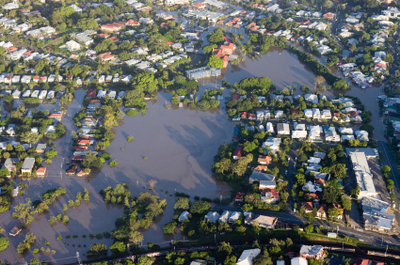
A rare bipartisan statute significantly reforms the National Flood Insurance Program.
Congress will soon be returning from a five-week recess, during which it left behind a lengthy list of uncompleted work: farmers facing one of the most devastating drought seasons in 50 years are unclear whether they will receive federal assistance; over $100 billion in across-the-board cuts are expected to impact domestic programs and military spending on January 2, 2013, without much thought given to how to balance efficiency and equity; the future of the United States Postal Service and its nearly 600,000 employees is uncertain, again. Just to mention a few examples.
It is thus not surprising that according to the monthly Gallup Poll in July, 84 percent of Americans disapproved of how Congress was handling its job. This approval rating is at the extreme low end of the historical spectrum since Gallup initiated this question in 1974.
To provide some balance to this story, it is worth noting a positive achievement by the current Congress. In a rare bipartisan move, Congress and the president enacted an important piece of legislation that will affect millions of Americans. Surprisingly this new law has remained virtually unnoticed by the leading newspapers and television media.
The Biggert-Waters Flood Insurance Reform Act of 2012 was passed by Congress on June 29, 2012 and signed into law by President Obama on July 6, 2012. The Act renews for five years and significantly reforms the federally-run National Flood Insurance Program (NFIP).
The NFIP was authorized in 1968 because the private insurance industry believed flood risk was uninsurable ever since the severe floods of 1927 and 1928. Insurers were concerned with their ability to correctly price the product resulting in problems of adverse selection (i.e. only highly exposed individuals will want coverage which would lead to high concentration of risk) and possible catastrophic losses.
The NFIP provides residents in flood prone areas with flood insurance covering up to $250,000 for damage to property and $100,000 for content losses (private insurers offer coverage above this level but this represents only about 5 percent of the market). Insurers partner with the Federal Emergency Management Agency (FEMA) by selling policies and settling claims on behalf of the federal government in exchange for a fee but do not bear any risk.
The scope of this public disaster insurance program has increased significantly since its inception due to more people living in harms’ way, many of whom have been required to purchase flood insurance. The total value of property insured under the program increased from $165 billion in 1978 to $1.26 trillion today, covering 5.6 million property owners.
But the program had to borrow $18 billion from the U.S. Treasury to pay an historical level of claims from the 2005 and 2008 hurricane seasons, leading to calls for reform by the U.S. Congress, FEMA and flood hazard and disaster financing experts alike.
It is common knowledge that the program faces numerous challenges. According to the Government Accountability Office, 50 percent of the NFIP’s roughly 106,000 hazard maps were more than 15 years old in April 2008 and many do not accurately reflect the flood risk. Our levee system is aging so many people are not as well protected as they think. Moreover, a large number of policyholders are paying premiums significantly below their actuarially fair price. Indeed, people purchasing flood insurance for houses that were built before the introduction of flood insurance rate maps benefit from subsidized rates. By design, this makes the program financially unsustainable in the long run. This also creates a form of moral hazard: people move to hazard prone areas knowing they can benefit from subsidized insurance. Related to this point, a small percentage of houses that experience multiple floods account for a large portion of all claims paid. In 2009 there were about 71,000 insured “repetitive loss properties,” which represented only 1.2 percent of the NFIP portfolio but accounted for 16 percent of total claim payments between 1978 and 2008.
There is also empirical evidence that a large number of residents who are required to have flood coverage as a condition for their federally insured mortgage are uninsured, most likely because they canceled their policy just a few years after purchasing one. Many uninsured victims then turn to the federal government for help in the aftermath of a disaster.
In other words, the NFIP needed fixing. Until last month, Congress had approved only short-term extensions of the NFIP, seventeen since September 2008. At the same time between 2010 and 2012, both chambers in the U.S. Congress started to work more closely with FEMA, the Congressional Research Service, the Office of Management and Budget, the insurance industry, and experts in the field. Numerous workshops and national public conferences were held to discuss ways to redesign flood risk management and flood insurance in the United States and to hear contrasting views. Several leading research institutions undertook economic analyses quantifying the challenges the NFIP program was facing and proposing innovations to Congress for dealing with these problems.
The resulting law is well-balanced and comprehensive. It is designed to restore personal responsibility and does so in fair way. For example, it requires that the NFIP move to risk-based premiums over five years to allow residents to adjust to this change. The Act also recognizes that additional analysis needs to be undertaken to make the program more efficient and equitable, requesting several studies, including one on the feasibility of means-based insurance vouchers to address insurance affordability, a study on the use of private reinsurance and alternative risk transfer instruments to limit taxpayers’ exposure, and a study examining a possible increased risk-sharing role for private insurers.
The work to reform the NFIP that took place over the past two years will ultimately help America become more resilient to future floods. It is very refreshing when Congress comes together to make positive changes.
We should all notice when this occurs.





